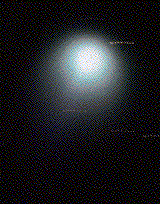 89K
89K

 35K
35K
Observer: Roar Skartlien
Location: Hagar Observatory, Norway
Date: March 27, 1996
Here are some pictures of Comet Hyakutake that I took during the first hours of the twenty seventh day in March 1996. It was close to the Earth, only at a distance of 15 million kilometer. The comet passed right above us, giving extremely good observing conditions at 60 degrees latitude, with the long tail crossing zenith in Ursae Major around midnight. We were then close to the orbital plane of the comet, such that the gas and dust tails were apparently pointing in the same direction.
The coma (hair) appeared blue/green possibly due to the mixing of reflected yellow sunlight from dust grains and blue C2 emission from the gas. C2 is two carbon atoms connected together forming a molecule. Changes in rotational and vibrational energy of C2 are the cause of light emission at distinct colours.
The visual magnitude of the coma was approximately 0.0 which is the same as Vega in Lyrae and Arcturus in Bootes. The nucleus appeared as a star like point, surrounded by a round coma. Spikes/lanes of dust/gas appeared right behind the coma in binoculars. The tail could be seen as long as 50 to 60 degrees during the best observing conditions. Patches of gas along the tail could also be seen in the binoculars.
All photographs and observations were made at the H�g�r amateur observatory in Norway, approximately 100 km. north of Oslo. Here I spend many weekends during the dark season, gazing at the heavenly objects.
Roar Skartlien
 Comet 1996 B2 Hyakutake Home Page
Comet 1996 B2 Hyakutake Home Page
